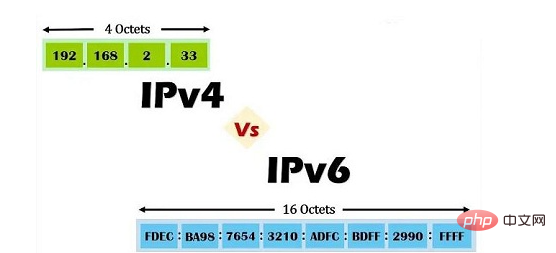
The IP address is composed of 32 or 128-bit binary numbers. IP address is a unified address format provided by the IP protocol. There are two types of IP addresses: 1. IPv4 address, which consists of 32-bit binary numbers, expressed in dotted decimal notation, divided into eight bits, that is, four 0~255 Decimal number; 2. IPv6 address consists of 128-bit binary number, expressed in dotted hexadecimal, divided into eight bits, that is, sixteen hexadecimal numbers from 0x00 to 0xff.

The operating environment of this tutorial: Windows 7 system, Dell G3 computer.
IP address (Internet Protocol Address) refers to the Internet Protocol address, also translated as Internet Protocol address.
The IP address is a unified address format provided by the IP protocol. It assigns a logical address to each network and each host on the Internet to shield the differences in physical addresses.
There are two types of IP addresses: ipv4 address and ipv6 address.
An IPv4 address consists of a 32-bit binary number, while an IPv6 address consists of a 128-bit binary number.
IPv4 addresses are binary numbers expressed as decimals. IPv6 addresses are binary numbers represented in hexadecimal notation.

What is ipv4
Internet Protocol Version 4 (English: Internet Protocol version 4 (IPv4), also known as the fourth version of the Internet Communication Protocol, is the fourth revised version in the development process of the Internet Protocol and the first widely deployed version of this protocol. IPv4 is the core of the Internet and the most widely used version of the Internet Protocol. Its successor version is IPv6. Until 2011, when the IANA IPv4 addresses were completely exhausted, IPv6 was still in the early stages of deployment.
The IPv4 address is 32 bits, expressed in dotted decimal notation, divided into eight bits, that is, four decimal numbers from 0 to 255, which is very common.
IPv4 uses 32-bit (4-byte) addresses, so there are only 4,294,967,296 (2) addresses in the address space. However, some addresses are reserved for special purposes, such as private networks (about 18 million addresses) and multicast addresses (about 270 million addresses), which reduces the number of addresses that can be routed on the Internet. As addresses continue to be allocated to end users, the problem of IPv4 address exhaustion is also arising. Address structure reconstruction based on classified networks, classless inter-domain routing, and network address translation significantly reduces the rate of address exhaustion. But on February 3, 2011, after the last five address blocks had been allocated to the five regional Internet registries, IANA's main address pool was exhausted.
These limitations have spurred the deployment of IPv6, which is still in its early stages of development and is the only long-term solution.
Address Format
An IPv4 address can be written in any form that represents a 32-bit integer value, but to facilitate human reading and analysis, it is usually written in dotted decimal notation form, that is, the four bytes are written separately in decimal notation, separated by dots.
The following table shows several different formats:
Format |
Value |
Conversion from dotted decimal |
|---|---|---|
Dotted decimal |
192.0.2.235 |
Not applicable |
| ##Dotted Hexadecimal | 0xC0.0x00.0x02.0xEB | Each byte is converted to hexadecimal individually |
| Dotted Octal | 0300.0000.0002.0353 | ##Each byte is converted to octal individually|
| 0xC00002EB | Divide the dots into ten Hexadecimal connected together | |
| 3221226219 | A 32-bit integer written in decimal | |
| 030000001353 | A 32-bit integer written in octal |
The above is the detailed content of How many binary digits does an IP address consist of?. For more information, please follow other related articles on the PHP Chinese website!